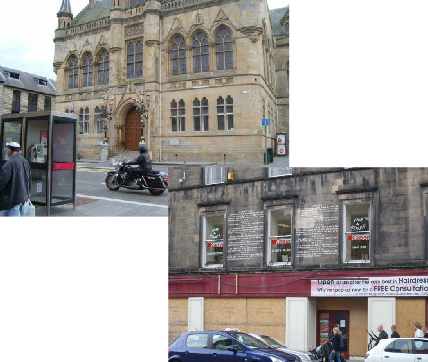Verses on the wall
The following are pictures of verses engraved into the wall of a building directly across the road from the main hall on the first floor of the Inverness Town Hall.
first published 04/05/2008
These engravings suggest a different atttitude to the Word of God to that held today. But as the eternal Word of God they are no less relevant.



If anyone has some knowledge about how the verses got there (it is thought that the rooms were at one time occupied by a Christian group) please leave what information you have below or e-mail the Editor. Thank you!
-----------
A Paul Munro of Inverloch, Victoria in Australia has supplied the following information
(24/05/2011):
The wall carvings opposite the Town House at High Street, Inverness are of particular interest to me. The current residents Kaper Hair and Beauty, give their address as number 3 High Street, so unless the street numbers have changed over the years I would assume this to be the same building that was once occupied by my great grandfather James Edward Munro.
The Inverness Advertiser of 17 November 1868 informs that James died at 3 High Street on 7 November of that year. He would have been a tenant rather than the proprietor, having returned to Scotland from Westminster where he lived in May 1864, to be with his brother Baillie Chisholm Munro who died of tuberculosis at Cawdor Village, Nairn on 20 July that year. James also died of tuberculosis, his death certificate stating he had suffered for four years, so he no doubt caught the disease from brother Baillie.
Their mother Ann Munro nee Chisholm died from tuberculosis on 28 March 1866 at 12 Wells Street, having suffered for eight months. The reason I mention this is because both 3 High Street, and 12 Wells Street had been earlier occupied by a so far unrelated William Munro - a self-styled architect. William was baptised at Evanton on 23 April 1806, the son of Kiltearn shoemaker Hugh Munro and Hectorina MacKenzie, and he married Jane MacBean of Ness Walk at Inverness on 26 May 1835 as a mason of Chapel Street.
William must have tried his hand at everything, because in 1841 he was a bookseller living with Jane and the first two of his four children at Queen Street. He had moved to 6 Celt Street by 1851, and according to the census, was an architect. He ran an advertisment in the Inverness Advertiser on 19 June 1855 as William Munro, architect of 3 High Street, for the sale of "a large cargo of superior Welsh slates", so was living opposite the Town House at least nine years prior to James.
More correctly, both William and James would have lived opposite the old Town Hall, as I believe construction of the present Town House didn't commence until circa 1878, with the opening ceremony taking place in January 1882. The 1861 census finds William as an architect at 12 Wells Street, where James's parents were living in 1866. Eleven days before James died Donald lost another son, Duncan Chisholm Munro, at Arlington Square, London, and the Inverness Advertiser death notice gives Donald's address at that time as Waterloo Place, but doesn't provide a street address.
Duncan Chisholm Munro and another brother, John Chisholm Munro, were boarding with the Jack family at 15 Waterloo Place in 1861, and there are indirect references to William Munro at Waterloo Place, including one through his daughter Elizabeth who was at 3 Waterloo Place for the 1871 census when married to John Miller.
I would like to think that the words were carved on the wall of number 3 during the residency of James Edward Munro, or maybe even earlier when William the architect lived there, but my gut feeling is that they were done either to coincide with the opening of the new Town House in 1882, or possibly later.
There is nothing at all old English about the style of language used, in fact it could have been written yesterday. The Caledonian building next to number 3 is now home to the Smith & Jones Pub, and the current proprietor might not appreciate the references to drink and drunkards, but if the Caledonian was also a hotel back in the 19th century, the references might have been aimed at it's patrons as well as the delinquent councilors.
For anyone interested in the relationship between William Munro the architect, and Donald Munro who married Ann Chisholm, I can find nothing other than circumstantial evidence, but believe they will eventually prove to be related. Donald was born at Kilmuir Easter, and baptised there on 7 November 1795, the son of Donald Munro, merchant and tailor of Tullich, and Catherine McKenzie. Donald Snr died at Kilmuir Easter on 26 November 1846 aged 81.
Inverloch, Victoria
 Paul Munro Paul Munro
Inverloch, Victoria
|